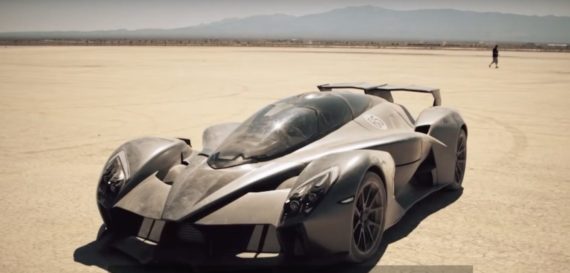January 14th, 2018 by Nicolas Zart
No doubt about it, proof-of-concept cars are cool, but rarely practical. Despite their unobtainium status, they are nonetheless very much needed. Here’s why.
The RAESR Wild Tachyon Speed Proof Of Concept
Mainstream car manufacturers would be happy if nothing changed. They modestly change the four-wheel people haulers every year or so. Left to their own devices, they tend to become complacent and lethargic. Given the billions of tax credits given to petroleum companies each year for fuel research and the modest fuel mileage increases of modern cars, electric vehicles (EV) show wild potential. Although the new Nissan LEAF is a great everyday EV and the Tesla Model S steals the luxury market share from 100-year-old carmakers, showing lagging traditional automobile makers that EVs are vastly superior to the antiquated internal combustion engine (ICE) is perhaps the best way to get everyone excited and demanding these cars.
The Southern Californian company RAESR (Rice Advanced Engineering Systems & Research) is doing just that with the Tachyon Speed, an EV proof of concept that showcases the superiority of an electric drivetrain.
We did say that most concepts and prototypes are not the most practical, at least in terms of everyday use — fair warning. The Tachyon Speed is low (exactly 39.5″ off the ground) and pretty wide (exactly 81″). It also sports a 6-motor configuration that gives it a 1,200 HP proprietary electric powertrain. And there is nothing better than to show the gasoline hypercar makers today that EVs can handle that crown now.
The Raesr Tachyon Speed pushes out 3,650 lb ft of torque with a .39 drag coefficient. It has a frontal area of only 17.75 sq ft, with a downforce at 150 mph of 400 lb. Helping to deliver this performance is a 532V, 2,650A battery pack delivering a mindblowing 1.4 MW of peak power for a respectable range of over 150 miles. That’s a phenomenal 1,877.431 of horsepower! And according to the company, it’s usable on streets. Oh, sweet dreams are made of this. But just one question: Can we test drive it? Seriously, now.
The rest of the specs are way out of the hands of an everyday driver, not to mention the driver’s wallet. The Tachyon Speed rests on a chromium molybdenum (Chromoly) tube frame with a kevlar interior tub. It weighs in at 2,950 lb and can sprint the 0 to 60 MPH in under 3 seconds, do the 0 to 120 in under 7 seconds and complete the 1/4 mile in under 10 seconds. Its top speed is over 240 MPH.
Of course, RAESR is not the first to show a super-performance EV. The Rimac Concept_One car, recently crashed by Richard Hammond, is a proof that EVs can take on the best of the best and are already available.
Who In The World Is RAESR?
RAESR is “a high-end automotive design and technology startup committed to crafting an exclusive number of hand-built electric and hybrid-electric hypercars.” In essence, the Tachyon Speed is the result of the company’s R&D in high-performance electric powertrains, prototyping, and energy storage systems. It’s a showcase of what can be done with an EV, and it blows away traditional gas cars.
 But why would anyone do that? The answer is simple. Because it can be done and EVs need to show they can take away the performance crown from high-end performance gasoline cars. EVs have the extraordinary potential of liberating us from the gas pump. We can create our very own electricity for our mobility needs using an EV. They also open floorplans to allow for more interior room, as the Tesla Model S and Lucid Air have shown. But mostly, they allow for more motor energy density. And batteries keep on getting better and more affordable.
But why would anyone do that? The answer is simple. Because it can be done and EVs need to show they can take away the performance crown from high-end performance gasoline cars. EVs have the extraordinary potential of liberating us from the gas pump. We can create our very own electricity for our mobility needs using an EV. They also open floorplans to allow for more interior room, as the Tesla Model S and Lucid Air have shown. But mostly, they allow for more motor energy density. And batteries keep on getting better and more affordable.
So, why do we need another proof of concept? Because it shows traditional gasoline carmakers in yet another way and example that ICE technology is no longer capable of sustaining our mobility needs. We’re happy to see companies as RAESR and the Venturi VBB3 hit 341.4 mph and take away a speed record. It shows what is possible. Proof-of-concept vehicles are needed to wake up the sleepy gas gurgling automotive giants. They are an also a reminder that we want performance EVs now and not in five to 10 years.
Additionally, such vehicles from startups like RAESR send a message to large automakers — “hey, we can do this for you if you need some help.” They’re advertisements for much bigger projects. Going back to the case of Rimac, it has landed big deals to do much of the underlying electrification work for Jaguar Land Rover and others. Supercars were not the end game. Supercars were super fun advertising work and helpful for startup funding.



